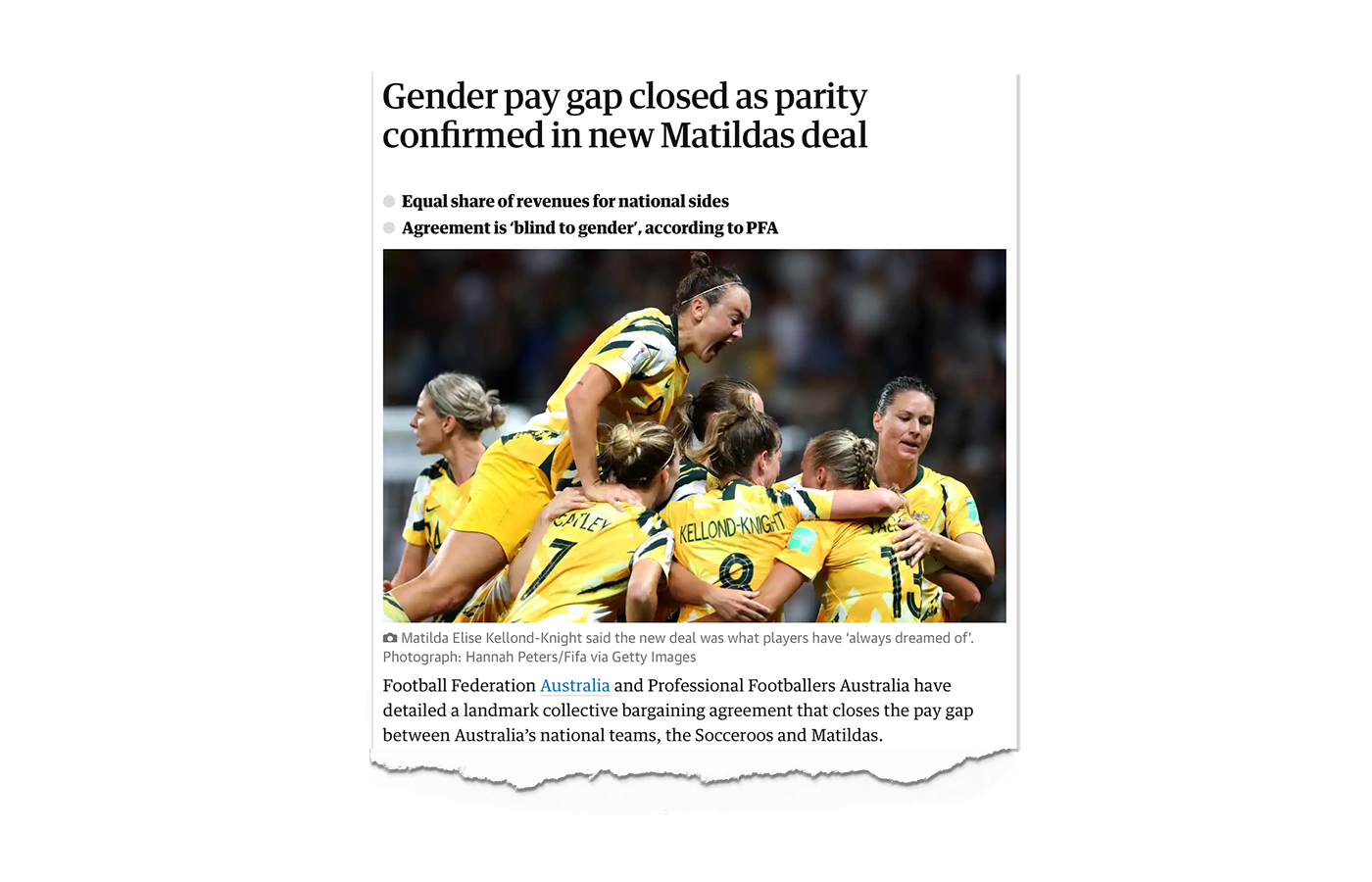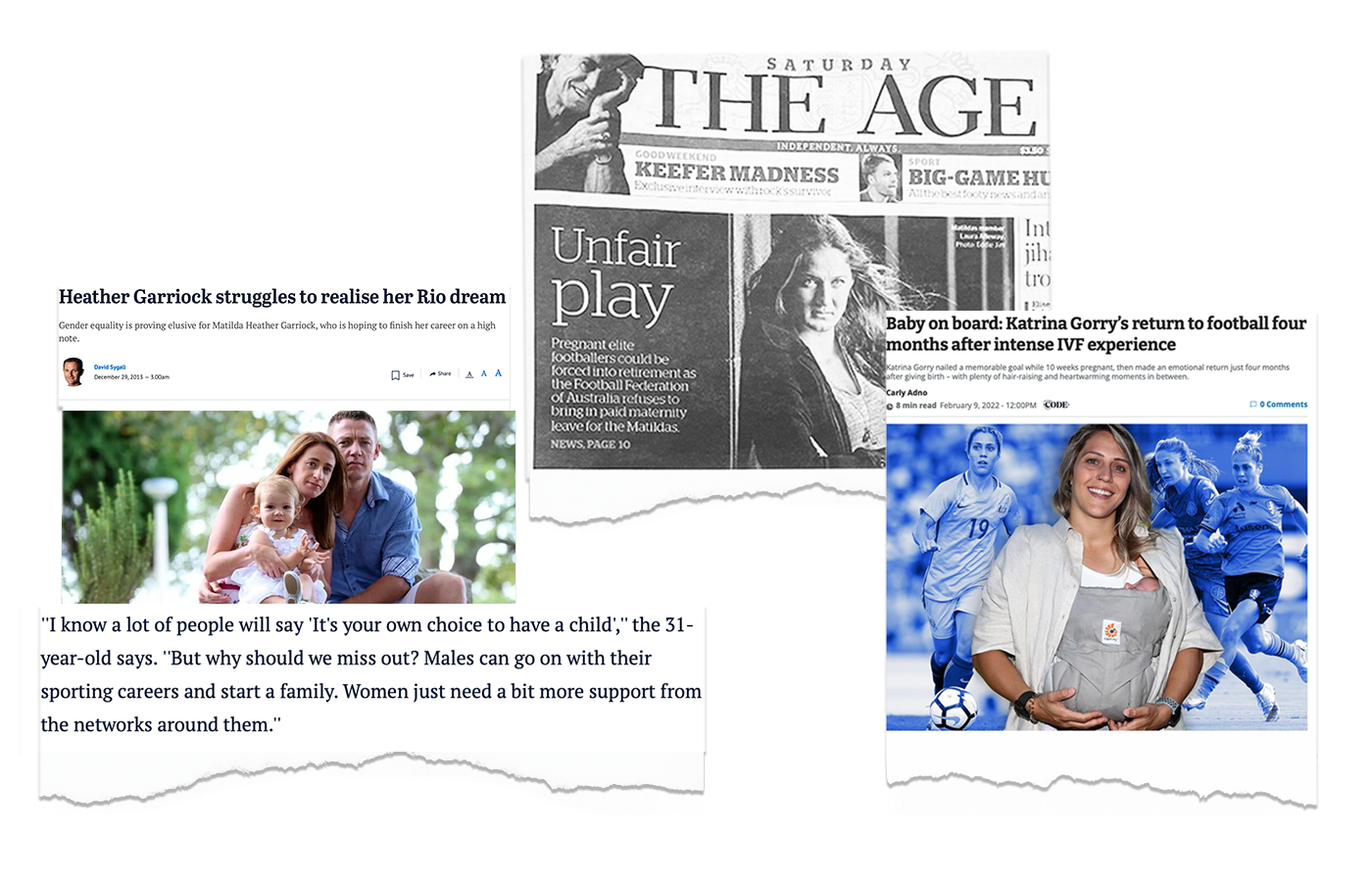It’s finally time for the Matildas’ home World Cup campaign, starting in Sydney against Republic of Ireland.
Their on-field contests will be underpinned by world class workplace standards won via off-field battles stretching back decades.
On the eve of the tournament, it’s important to recognise and celebrate the contributions of players past and present in earning the rights and conditions which this generation of Matildas are benefiting from.
The old saying goes that success has many fathers. That phrase is clearly outdated, but maybe it aptly captures the risk of others seeking to claim credit for progress which – to be clear – has been hard-won by players and their allies.
The Matildas have gone from washing their own kits and being paid less than minimum wage to achieving parity with the Socceroos within a generation. Many in the current dressing room have seen this whole journey play out.
They know nothing has been handed to them – they’ve had to earn every step. When they were told no, they organised and demanded outcomes. When they were told they asked too much, they proved they were worth more.
With hindsight, no one would now argue that their progress has been anything other than timely, deserved, morally correct, and economically justified. Australian football should be grateful to those who led us to this potentially transformative moment. But those doubters certainly existed, including on the other side of the bargaining table.
This PFA Post looks back at the players’ record of moving the ball forward through activism, sacrifice, and a raw determination to be treated with fairness and respect.
World-leading gender equal CBA
The landmark 2019-2023 National Teams Collective Bargaining Agreement (CBA) achieved gender equality between the Matildas and the Socceroos.
Under the deal, both teams are afforded identical performance standards, such as staffing levels and the quality of travel, accommodation, and training facilities. Both teams are paid equally: a share of the revenue they each generate for Football Australia (FA) is centrally pooled then split 50-50 across the two teams.

The one exception is prize money; the CBA guarantees each team the same minimum percentage of prize money from their respective tournaments, but FIFA and the AFC put much less money on the table for women to play for. More on that later.
The CBA will be a competitive advantage for the Matildas at the World Cup. The team will enjoy the same guaranteed standards that provided the Socceroos with a world class platform in Qatar last year. The Socceroos lauded their camp environment and culture in the PFA’s report on the Socceroos’ 2022 World Cup campaign.
Meanwhile, the vast majority of women’s national teams will come down under with no CBA in place. Some World Cup contenders prepare for the tournament amid public disputes over their conditions. Other nations, where collective bargaining is not yet entrenched, arrive in disarray due to missed payments and disappearing funds.
History should show that FFA (as it was known at the time) was a willing partner in embedding gender equality into the CBA in 2019, but it was the players – from both national teams – who led the fight for this principle.
‘Before 2007, we didn’t have a voice’
The 2019-2023 CBA was not born out of nothing. It was the fourth major agreement with FFA/FA which covered the Matildas, who first joined the PFA after the 2007 Women’s World Cup.
Early gains were modest. One of the first asks was for FFA to do the team’s laundry. But with each deal, the players demanded the bar be raised further, gradually closing the gender gap on the way to 2019’s equality milestone.
Cheryl Salisbury describes the players’ decision to join the PFA as a critical step:
“Back before 2007, we didn’t have a voice. We had no one to go into bat for us, unless it was the coach or the manager who was trying to get us new uniforms or uniforms that weren’t in men’s sizes or five times too big, those basic requirements that the blokes take for granted. These are the things we fought for, and some of those things we’re still fighting for today, we’ve just got a voice that can help us now.”
Lydia Williams, who was in the 2007 World Cup squad, this week reflected on 2015 as an inflection point when, following her third World Cup, the team escalated its efforts to win a basic wage above the Australian legal minimum:
“On the back of the tournament, there was the strike and the CBA agreement. That was a moment where we really believed in ourselves and that if we really invest in ourselves, we can really achieve something, and I think that was probably the start of where we are today.”
In the lead up to the World Cup, overdue stories are being told about women’s football trailblazers in the 1960s, 1970s, 1980s, and 1990s. It’s clear this struggle started long before the PFA was involved. The common thread from those historic teams to the modern era of collective bargaining is a player-led push for change. The game is always better off when the players’ voice is heard.
Collectively bargaining the right to parenthood
Katrina Gorry’s young daughter Harper has been described as the Matildas’ secret weapon. But it was not so long ago that players like Katrina and another Matildas mum, Tameka Yallop, were forced to choose between football and parenthood.
In 2013, Melissa Barbieri lost her Matildas contract when she decided to have a child. She was forced to sell her precious football memorabilia and rely on charity from male players to fund her playing return via the W-League.
That same year, FFA allowed Matildas midfielder Heather Garriock to bring her 11-month-old daughter Kaizen on tour with a full-time carer – at her own expense.
A carer was essential for Heather to meet her obligations as a player, but the costs were double her pay as a Matilda at the time. Fellow players, through the PFA, covered Heather’s expenses to bring her mother as Kaizen’s carer, but her experience was enough to force other players into an early retirement to start their families.
The PFA filed a grievance at the NSW Civil and Administrative Tribunal, which was rejected, but the players would not stop fighting until they received a fair policy.
In 2015, the lack of support offered for current or prospective mothers was one of the key reasons the Matildas took industrial action during the CBA negotiation with FFA. The players’ asks were written off as too expensive.
In 2019, the players were finally able to collectively bargain a world class policy: 12-months paid parental leave for a primary caregiver of any gender, additional support for those fostering or adopting, and carer provisions to allow for return-to-play.

Like many of their victories, it’s a win for the players, but also for the sport. The provision pays itself back by keeping Australia’s best players on the pitch, maximising our chances of capitalising on this World Cup opportunity.
The rapid progress of recent years has been a result of administrators recognising this positive sum nature of investment in women’s football.
Katrina’s story of childbirth, as told through the PFA, symbolises the strength and determination of the team’s fight to create this awakening.
World Cup prize money – the fight continues
A recent PFA Post explained the Women’s World Cup prize money at length. Several points bear repeating in the context of this Post:
- Prize money for the 2023 Women’s World Cup is 25% of that at the 2022 Men’s World Cup
- FIFA has been dragged kicking and screaming – by players and player organisations – to increase Women’s World Cup prize money
- FIFA frames itself as a champion for gender equal prize money being held back by external forces: this is incorrect
There is no collective bargaining at the FIFA level (yet), so the players are limited to lobbying, consultation, and public pressure. Extensive efforts on these fronts have led to a welcome increase to prize money, but ultimately, FIFA has decided not to provide equality for the current generation of players, even though it can easily afford to do so.
Mission incomplete
Gender equality is not the endgame, but a bare minimum we should expect from our institutions in this era.
Part of the next challenge is ensuring women’s voices are embedded in every aspect of their playing experience, from their workplace environment, to how they are commercialised, to their impact on society and the planet.
Issues disproportionately impacting women players need to be accounted for, such as bespoke health and safety considerations and workplaces safe from bullying and harassment.
Through collective bargaining at a domestic level, and, in future, internationally, women should not stop at gender equality, but work with men to ensure all players get a fair share of the revenues they generate.
Many of these themes form the basis for the Matildas’ and Socceroos’ “Players’ Vision” for the next National Teams CBA, which is currently being negotiated. In addition, the Matildas have expressed a desire for the A-League Women to be enhanced in the wake of the World Cup, to improve the pathway for their successors.
This World Cup can be both a celebration of gains made and a recognition there is more work to do.
The lesson here is that progress in women’s football is not about a destination, but a principle: when players speak, the game should listen.







